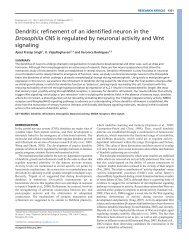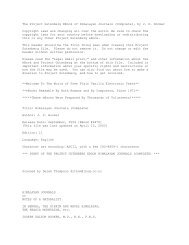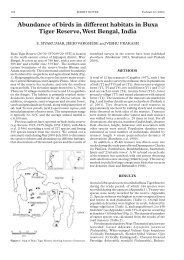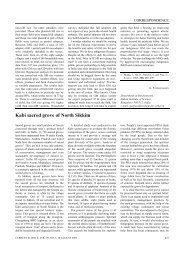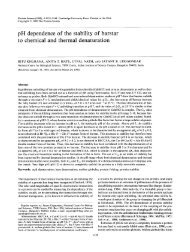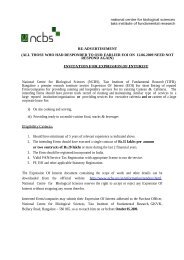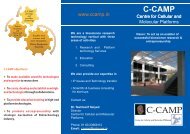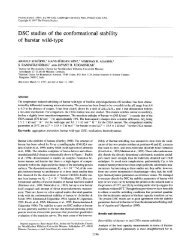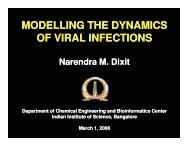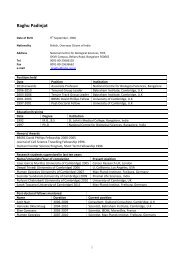Muscles in the Drosophila second thoracic segment are patterned ...
Muscles in the Drosophila second thoracic segment are patterned ...
Muscles in the Drosophila second thoracic segment are patterned ...
You also want an ePaper? Increase the reach of your titles
YUMPU automatically turns print PDFs into web optimized ePapers that Google loves.
Research Paper Homeotic gene function <strong>in</strong> <strong>Drosophila</strong> <strong>thoracic</strong> muscle development Roy et al. 225<br />
Figure 5<br />
Ectopic expression of Antp <strong>in</strong> T2 mesoderm dur<strong>in</strong>g pupal development<br />
results <strong>in</strong> disruption of flight muscle development. (a) SG29.1-GAL4<br />
driven UAS-lacZ expression <strong>in</strong> <strong>the</strong> pupal myoblasts of <strong>the</strong> IFMs at 12 h<br />
APF. Asterisks <strong>in</strong>dicate <strong>the</strong> positions of <strong>the</strong> three larval muscles that<br />
serve as templates for <strong>the</strong> development of one group of IFMs, <strong>the</strong><br />
dorsal-longitud<strong>in</strong>al muscles (DLMs). (b) SG29.1-GAL4 driven UAS-<br />
Antp expression <strong>in</strong> <strong>the</strong> pupal myoblasts of <strong>the</strong> IFMs at 12 h APF<br />
(arrowheads). (c) Wild-type hemithorax show<strong>in</strong>g <strong>the</strong> morphology of <strong>the</strong><br />
IFMs. The star <strong>in</strong>dicates one of <strong>the</strong> six DLM fibres. (d) Hemithorax of a<br />
SG29.1; UAS-Antp fly show<strong>in</strong>g disruption of <strong>the</strong> IFMs. Note complete<br />
absence of <strong>the</strong> DLMs. Some of <strong>the</strong> rema<strong>in</strong><strong>in</strong>g dorso-ventral muscles<br />
<strong>are</strong> visible. In (a,b), anterior is top; <strong>in</strong> (c,d), anterior is top right corner.<br />
3b). However, as Antp is nei<strong>the</strong>r expressed nor functional <strong>in</strong><br />
T2 mesoderm, misexpression of Antp <strong>in</strong> this mesoderm<br />
could affect muscle development, transform<strong>in</strong>g T2 muscle<br />
pattern towards a T3 pattern; this was found to be <strong>the</strong> case<br />
(Fig. 3d, comp<strong>are</strong> with 3b). Taken toge<strong>the</strong>r, <strong>the</strong>se results<br />
suggest that Antp has no autonomous mesodermal function<br />
<strong>in</strong> <strong>the</strong> development and pattern<strong>in</strong>g of T2-specific musculature<br />
<strong>in</strong> <strong>the</strong> embryo. They also show that Antp is <strong>the</strong><br />
homeotic selector gene required for autonomous specification<br />
of <strong>segment</strong>al identity <strong>in</strong> T3 mesoderm and, when misexpressed<br />
<strong>in</strong> T2 mesoderm, can transform <strong>the</strong> pattern of T2<br />
ventral muscles <strong>in</strong>to that of a T3-like identity.<br />
Analysis of mosaic embryos, <strong>in</strong> which Antp function was<br />
provided only <strong>in</strong> <strong>the</strong> ectoderm but was specifically absent<br />
from <strong>the</strong> mesodermal cells, also showed a significant app<strong>are</strong>nt<br />
restoration of T3 muscle pattern (Fig. 2d), even though<br />
Antp is normally expressed <strong>in</strong> <strong>the</strong> mesodermal cells and<br />
muscles of this <strong>segment</strong>. This is not surpris<strong>in</strong>g because T2<br />
and T3 muscle patterns <strong>are</strong> very similar, except for three<br />
ventral muscle fibres that develop <strong>in</strong> T3 and <strong>are</strong> absent<br />
from T2 (Fig. 3a). Thus, when Antp was expressed <strong>in</strong> <strong>the</strong><br />
ectoderm of Antp – animals, T3 resembled T2, <strong>in</strong> that Antp<br />
was expressed <strong>in</strong> <strong>the</strong> ectoderm and no homeotic selector<br />
gene was expressed <strong>in</strong> <strong>the</strong> mesoderm. In addition, misexpression<br />
of Antp <strong>in</strong> T2 mesodermal cells resulted <strong>in</strong> <strong>the</strong><br />
ectopic development of T3-like ventral fibres <strong>in</strong> T2, suggest<strong>in</strong>g<br />
that Antp normally modifies <strong>the</strong> ‘ground plan’ of T2<br />
muscles <strong>in</strong>to a T3-specific pattern (Fig. 3c,d).<br />
We next determ<strong>in</strong>ed whe<strong>the</strong>r <strong>the</strong> mesodermal profile of<br />
Antp expression dur<strong>in</strong>g pupal development had <strong>the</strong> same<br />
<strong>segment</strong>al restrictions as that seen <strong>in</strong> <strong>the</strong> embryo. The <strong>in</strong>direct<br />
flight muscles (IFMs) develop <strong>in</strong> <strong>the</strong> T2 <strong>segment</strong> and<br />
<strong>the</strong>ir progenitors <strong>are</strong> myoblasts located on <strong>the</strong> T2 w<strong>in</strong>g<br />
imag<strong>in</strong>al discs [14]. These adult muscles offer a good model<br />
system for study<strong>in</strong>g <strong>the</strong> genetics of <strong>segment</strong>-specific<br />
muscle pattern<strong>in</strong>g, and <strong>the</strong>ir normal development has been<br />
well documented [15,16]. We found that <strong>the</strong> T2 w<strong>in</strong>g disc<br />
myoblasts did not express Antp (Fig. 4a), whereas <strong>the</strong><br />
myoblasts on <strong>the</strong> T3 haltere disc did express Antp (Fig. 4b).<br />
Animals homozygous for three Ubx mutations — anterobithorax,<br />
abx; bithorax 3 , bx 3 ; postbithorax, pbx — show a transformation<br />
of T3 towards T2: such ‘triple-mutant’ adults have<br />
two pairs of w<strong>in</strong>gs (<strong>the</strong> ‘four-w<strong>in</strong>ged fly’). However, <strong>the</strong><br />
homeotically transformed T3 (HT3) has only rudimentary<br />
IFMs [17,18]. We had shown earlier that <strong>the</strong> transformation<br />
of <strong>the</strong> ectoderm from T3 to T2 <strong>in</strong> <strong>the</strong>se triple-mutant<br />
animals causes <strong>the</strong> transformation of key aspects of muscle<br />
development: <strong>the</strong> number of myoblasts on <strong>the</strong> HT3 w<strong>in</strong>g<br />
imag<strong>in</strong>al disc and <strong>the</strong> pattern of migration of <strong>the</strong>se<br />
myoblasts dur<strong>in</strong>g pupal development <strong>are</strong> transformed<br />
towards a T2 identity [7]. These results demonstrated that<br />
<strong>in</strong>ductive <strong>in</strong>fluences <strong>are</strong> necessary but not sufficient for<br />
muscle transformation. As <strong>the</strong> four-w<strong>in</strong>ged fly has rudimentary/no<br />
flight muscles <strong>in</strong> HT3, we had argued that a critical<br />
mesodermal transformation had not taken place, because<br />
T3 mesoderm-specific selector gene expression and function<br />
is unaltered <strong>in</strong> <strong>the</strong> triple mutant [7]. Our current observations<br />
show that Antp is <strong>the</strong> selector gene <strong>in</strong> T3 mesoderm,<br />
but we <strong>are</strong> unable to identify <strong>the</strong> expression or function of<br />
any known selector gene <strong>in</strong> T2 mesoderm. In <strong>the</strong> Ubx<br />
triple-mutant larvae, we found that myoblasts on HT3 w<strong>in</strong>g<br />
imag<strong>in</strong>al discs cont<strong>in</strong>ued to express Antp (Fig. 4c), whereas<br />
myoblasts on T2 w<strong>in</strong>g discs did not (Fig. 4a).<br />
Dur<strong>in</strong>g <strong>the</strong> pupal development of wild-type animals, Antp is<br />
expressed <strong>in</strong> T3 mesoderm but is absent <strong>in</strong> <strong>the</strong> T2 mesoderm<br />
(Fig. 4d). In Ubx triple-mutant pupae, Antp expression<br />
cont<strong>in</strong>ues to be seen <strong>in</strong> HT3 myoblasts (Fig. 4e). If this<br />
cont<strong>in</strong>ued expression is a factor <strong>in</strong> <strong>the</strong> failure of IFM development<br />
to take place <strong>in</strong> HT3, <strong>the</strong>n we predicted that misexpression<br />
of Antp <strong>in</strong> T2 mesoderm dur<strong>in</strong>g pupal<br />
development could disrupt IFM development. The misexpression<br />
of Antp <strong>in</strong> <strong>the</strong> IFM progenitor myoblasts (Fig. 5a)



